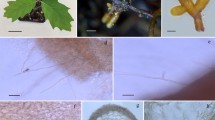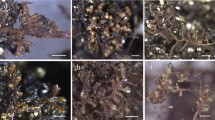Abstract
Modern truffle cultivation systems started in Europe in the early 1970s and are now successfully used for several European truffles throughout the world. However, systems for indigenous novel truffle species need to be developed in several regions, especially where truffle cultivation has not been attempted so far, such as in Japan. Recently, two new and one known truffle species that are expected to be edible were reported from Japan: Tuber japonicum, T. longispinosum, and T. himalayense. Here, we conducted mycorrhization trials between these three truffle species and four native tree species in Japan (Quercus acutissima, Q. phillyraeoides, Q. serrata, and Pinus densiflora) using spore suspension and trap-plant seedling techniques under axenic pot culture conditions to understand their potential host ranges and mycorrhizal morphologies and to determine whether these inoculation methods are applicable for mycorrhization of Japanese truffles with native host plants. Of the 12 combinations, nine were successful for mycorrhization, including both oak and pine trees. The T. japonicum mycorrhiza was characterized by short, needle-shaped cystidia without septa, whereas the two black truffles, T. longispinosum and T. himalayense, were indistinguishable from each other because they shared the same morphological and anatomical characters such as brownish, long cystidia with right angle ramification. These features were similar to related black truffle species. The results of the present study indicate that the inoculation method used for European truffles can also be applied for mycorrhization between Japanese truffle species and compatible native pine and/or oak hosts in Japan.





Similar content being viewed by others
References
Agerer R (1987–2002) Colour atlas of ectomycorrhizae, 1st–12th del. Einhorn-Verlag, Schwäbisch Gmünd
Altschul SF, Madden TL, Schäffer AA, Zhang J, Zhang Z, Miller W, Lipman DJ (1997) Gapped BLAST and PSI-BLAST: a new generation of protein database search programs. Nucleic Acid Res 25:3389–3402
Benucci GM, Bonito G, Baciarelli Falini L, Bencivenga M (2012) Mycorrhization of pecan trees (Carya illinoinensis) with commercial truffle species: Tuber aestivum Vittad. and Tuber borchii Vittad. Mycorrhiza 22:383–392. https://doi.org/10.1007/s00572-011-0413-z
Bonito G, Gryganskyi AP, Trappe JM, Vilgalys R (2010a) A global meta-analysis of Tuber ITS rDNA sequences: species diversity, host associations and long-distance dispersal. Mol Ecol 19:4994–5008. https://doi.org/10.1111/j.1365-294X.2010.04855.x
Bonito G, Smith ME (2016) General systematic position of the truffles: evolutionary theories. In: Zambonelli A, Iotti M, Murat C (eds) True truffle (Tuber spp.) in the World. Springer-Verlag, Berlin, pp 3–18. https://doi.org/10.1007/978-3-319-31436-5
Bonito G, Smith ME, Nowak M, Healy RA, Guevara G, Cazares E, Kinoshita A, Nouhra ER, Dominguez LS, Tedersoo L, Murat C, Wang Y, Moreno BA, Pfister DH, Nara K, Zambonelli A, Trappe JM, Vilgalys R (2013) Historical biogeography and diversification of truffles in the Tuberaceae and their newly identified southern hemisphere sister lineage. PLoS One 8:e52765. https://doi.org/10.1371/journal.pone.0052765
Bonito G, Trappe JM, Donovan S, Vilgalys R (2011) The Asian black truffle Tuber indicum can form ectomycorrhizas with north American host plants and complete its life cycle in non-native soils. Funct Ecol 4:83–93. https://doi.org/10.1016/j.funeco.2010.08.003
Bonito G, Trappe JM, Rawlinson P, Vilgalys R (2010b) Improved resolution of major clades within tuber and taxonomy of species within the Tuber gibbosum complex. Mycologia 102:1042–1057. https://doi.org/10.3852/09-213
Boutahir S, Iotti M, Piattoni F, Zambonelli A (2013) Morphological and molecular characterization of Tuber oligospermum mycorrhizas. Afr J Agric Res 8:4081–4087. https://doi.org/10.5897/AJAR2013.7354
Castresana J (2000) Selection of conserved blocks from multiple alignments for their use in phylogenetic analysis. Mol Biol Evol 71:540–552
Comandini O, Pacioni G (1997) Mycorrhizae of Asian black truffles, Tuber himalayense and T indicum. Mycotaxon 63:77–86
Deng XJ, Yu F, Liu P-G (2014) Contribution to confirmed and synthesized on mycorrhizae of Tuber indicum s.l. with two dominated and subalpine broadleaf trees in southwestern China. Am J Plant Sci 5:3269–3279. https://doi.org/10.4236/ajps.2014.521341
Feng B, Zhao Q, Xu J, Qin J, Yang ZL (2016) Drainage isolation and climate change-driven population expansion shape the genetic structures of Tuber indicum complex in the Hengduan Mountains region. Sci Rep 6:21811. https://doi.org/10.1038/srep21811
García-Montero L, Massimo GD, Manjón JL, García-Abril A (2008) New data on ectomycorrhizae and soils of the Chinese truffles Tuber pseudoexcavatum and Tuber indicum, and their impact on truffle cultivation. Mycorrhiza 19:7–14. https://doi.org/10.1007/s00572-008-0198-x
Gardes M, Bruns TD (1993) ITS primers with enhanced specificity for basidiomycetes–application to the identification of mycorrhizae and rusts. Mol Ecol 2:113–118
Geng L-Y, Wang X-H, Yu F-Q, Deng X-J, Tian X-F, Shi X-F, Xie X-D, Liu P-G, Shen Y-Y (2009) Mycorrhizal synthesis of Tuber indicum with two indigenous hosts, Castanea mollissima and Pinus armandii. Mycorrhiza 19:461–467. https://doi.org/10.1007/s00572-009-0247-0
Giomaro G, Zambonelli A, Sisti D, Cecchini M, Evangelista V, Stocchi V (2000) Anatomical and morphological characterization of mycorrhizas of five strains of Tuber borchii Vittad. Mycorrhiza 10:107–114. https://doi.org/10.1007/s005720000065
Guindon S, Dufayard JF, Lefort V, Anisimova M, Hordijk W, Gascuel O (2010) New algorithms and methods to estimate maximum-likelihood phylogenies: assessing the performance of PhyML 3.0. Syst Biol 59:307–321. https://doi.org/10.1093/sysbio/syq010
Hall IR, Brown GT, Zambonelli A (2007) Taming the truffle. The history, Iore and science of the ultimate mushroom. Timber Press, USA
Hu H-T (1992) Tuber formosanum sp. nov. and its mycorrhizal associations. J Exp For Nat For Nat Taiwan Univ 6:79–86
Huang J-Y, Hu H-T, Shen W-C (2009) Phylogenetic study of two truffles, Tuber formosanum and Tuber furfuraceum identified from Taiwan. FEMS Microb Lett 294:157–171. https://doi.org/10.1111/j.1574-6968.2009.01571.x
Katoh K, Standley DM (2013) MAFFT multiple sequence alignment software version 7: improvements in performance and usability. Mol Biol Evol 30:772–780. https://doi.org/10.1093/molbev/mst010
Kinoshita A, Sasaki H, Nara K (2011) Phylogeny and diversity of Japanese truffles (Tuber spp.) inferred from sequences of four nuclear loci. Mycologia 103:779–794. https://doi.org/10.3852/10-138
Kinoshita A, Sasaki H, Nara K (2016) Two new truffle species, Tuber japonicum and Tuber flavidosporum spp. nov. found from Japan. Mycoscience 57:366–373. https://doi.org/10.1016/j.myc.2016.06.006
Kinoshita A, Nara K, Sasaki H, Feng B, Obase K, Yang Z-L, Yamanaka T (2018) Using mating-type loci to improve taxonomy of the Tuber indicum complex, and discovery of a new species, T. longispinosum. PLoS One 13(3):e0193745. https://doi.org/10.1371/journal.pone.0193745
Lancellotti F, Iotti M, Zambonelli A, Franceschini A (2016) The puberulum group sensu lato (whitish truffles). In: Zambonelli A, Iotti A, Murat C (eds) Truffle (Tuber spp.) in the world: soil ecology, systematics and biochemistry. Soil Biology 47. Springer-Verlag, Berlin, pp 105–124. https://doi.org/10.1007/978-3-319-31436-5
Lefevre C (2012) Native and cultivated truffles of North America. In: Zambonelli A, Bonito G (eds) Edible ectomycorrhizal mushrooms. Soil Biology 34. Springer-Verlag, Berlin, pp 209–226. https://doi.org/10.1007/978-3-642-33823-6
Qiao P, Tian W, Liu P, Yu F, Chen J, Deng X, Wan S, Wang R, Wang Y, Guo H (2018) Phylogeography and population genetic analyses reveal the speciation of the Tuber indicum complex. Fungal Genet Biol 113:14–23. https://doi.org/10.1016/j.fgb.2018.02.001
Sasaki H, Kinoshita A, Nara K (2016) An illustrated book of Japanese truffles. Seibundoshinkosha, Tokyo (in Japanese)
Tamura K, Stecher G, Peterson D, Filipski A, Kumar S (2013) MEGA6: molecular evolutionary genetics analysis version 6.0. Mol Biol Evol 30:2725–2729. https://doi.org/10.1093/molbev/mst197
Wan SP, Yu FQ, Tang L, Wang R, Wang Y, Liu PG, Wang XH, Zheng Y (2016) Ectomycorrhizae of Tuber huidongense and T. liyuanum with Castanea mollissima and Pinus armandii. Mycorrhiza 26:249–256. https://doi.org/10.1007/s00572-015-0663-2
Wang Y (2012) Truffle cultivation in China. In: Zambonelli A, Bonito G (eds) Edible ectomycorrhizal mushrooms. Soil Biology 34. Springer-Verlag, Berlin, pp 227–240
Wang Y, Hall IR (2004) Edible ectomycorrhizal mushrooms: challenges and achievements. Can J Bot (Rev Can Bot) 82:1063–1073. https://doi.org/10.1139/b04-051
White TJ, Bruns TD, Lee S, Taylor JW (1990) Amplification and direct sequencing of fungal ribosomal RNA genes for phylogenetics. In: Gelfand MA, Sninsky DH, White TJ (eds) PCR Protocols. A guide to methods and applications. Academic Press, SanDiego, pp 315–322
Zambonelli A, Pisi AN, Tibiletti E, Penjor E (1997) Caratterizzazione anatomo-morfologica delle micorriza de Tuber indicum Cooke & Massee su Pinus pinea l. e Quercus cerris l. Micol Ital 1:29–36
Zambonelli A, Iotti M, Amicucci A, Pisi A (1999) Caratterizzazione anatomo-morfologica delle micorrize di Tuber maculatum Vittad. su Ostrya carpinifolia Scop. Micol Ital 3:29–35
Zambonelli A, Iotti M, Boutahir S, Lancellotti E, Perini C, Pacioni G (2012) Ectomycorrhizal fungal communities of edible ectomycorrhizal mushrooms. In: Zambonelli A, Bonito G (eds) Edible ectomycorrhizal mushrooms. Soil Biology 34. Springer-Verlag, Berlin, pp 105–124. https://doi.org/10.1007/978-3-642-33823-6
Zeppa S, Sisti D, Pierleoni R, Potenza L, Guescini M, Vallorani L, Stocchi V (2005) Tilia platyphyllos Scop.-Tuber brumale Vittad. vs. T. platyphyllos Scop.-T. borchii Vittad. ectomycorrhizal systems: a comparison of structural and functional traits. Plant Physiol Biochem 43:209–716. https://doi.org/10.1016/j.plaphy.2005.06.008
Funding
This work was supported by a grant from the Ministry of Agriculture, Forestry and Fisheries of Japan, entitled “Technology development for the optimal use of forest resources.” We thank Junichi Abe Peter, Hideo Hara, and Minoru Nakajima for collecting samples. We thank Robbie Lewis, MSc, from Edanz Group (www.edanzediting.com/ac), for editing a draft of this manuscript.
Author information
Authors and Affiliations
Corresponding author
Rights and permissions
About this article
Cite this article
Kinoshita, A., Obase, K. & Yamanaka, T. Ectomycorrhizae formed by three Japanese truffle species (Tuber japonicum, T. longispinosum, and T. himalayense) on indigenous oak and pine species. Mycorrhiza 28, 679–690 (2018). https://doi.org/10.1007/s00572-018-0860-x
Received:
Accepted:
Published:
Issue Date:
DOI: https://doi.org/10.1007/s00572-018-0860-x




